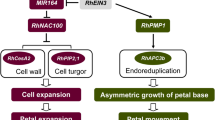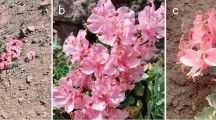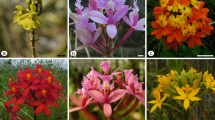Abstract
The flowers of Digitalis purpurea respond to pollination by rapid corolla abscission without any loss of corolla turgor, nor any significant loss of corolla constituents, relative to the corollas of unpollinated flowers of a similar age. The corollas of unpollinated flowers too eventually abscise, 6 d after the stigma opens, however, they do so with only a minimal loss of fresh weight or corolla constituents. Pollination causes an increase in ethylene production detectable within 1 h. Increased ethylene production occurs initially only from the upper portion of the style, later from the lower portion, and lastly, between 23 and 48 h after pollination, from the ovary plus calyx. The pollination response can be induced by exogenous ethylene, the degree of weakening of the corolla abscission zone being dependent upon the concentration and duration of the exposure period and on the stage of flower development. The regulation of ethylene biosynthesis and its involvement in the control of pollination-induced corolla abscission are discussed.
Similar content being viewed by others
References
Beutelmann, P., Kende, H. (1977) Membrane lipids in senescing flower tissue of Ipomoea tricolor. Plant Physiol. 59, 888–893
Blumenfeld, A. (1975) Ethylene and the Annona flower. Plant Physiol. 55, 265–269
Borochov, A., Halevy, A.H., Borochov, H., Shinitzky, M. (1978) Microviscosity of plasmalemmas in rose petals as affected by age and environmental factors. Plant Physiol. 61, 812–815
Borochov, A., Halevy, A.H., Shinitzky, M. (1976) Increase in microviscosity with aging in protoplast plasmalemma of rose petals. Nature (London) 263, 158–159
Burg, S.P., Dijkman, M.J. (1967) Ethylene and auxin participation in pollen induced fading of Vanda orchid blossoms. Plant Physiol. 42, 1648–1650
Halevy, A.H., Mayak, S. (1981) Senescence and postharvest physiology of cut flowers. Part 2. Hortic. Rev. 3, 59–143
Hall, I.V., Forsyth, F.R. (1967) Production of ethylene by flowers following pollination and treatments with water and auxin. Can. J. Bot. 45, 1163–1165
Hori, T., Fuji, M. (1961) On the growth substance economy before and after flowering in each organ of Portulaca grandiflora (Hook). Bot. Mag. 74, 357–360
Israeli, Y., Blumenfeld, A. (1980) Ethylene production by banana flowers. Hortic. Sci. 15, 187–189
Kende, H., Baumgartner, B. (1974) Regulation of aging in flowers of Ipomoea tricolor by ethylene. Planta 116, 279–289
Kende, H., Hanson, A.D. (1976) Relationship between ethylene evolution and senescence in morning glory flower tissue. Plant Physiol. 57, 523–527
Lim, S.L., Chin, T.Y., Hew, C.S. (1975) Biochemical changes accompanying the senescence of Arundina flower. In: Biology in society, pp. 18–26. Academy of Science, Singapore
Lipe, J.A., Morgan, P.W. (1973) Location of ethylene production in cotton flowers and dehiscing fruits. Planta 115, 93–96
Matile, P., Winkenbach, F. (1971) Function of lysosomes and lysosomal enzymes in the senescing corolla of the morning glory (Ipomoea purpurea). J. Exp. Bot. 22, 759–771
Mayak, S., Halevy, A.H. (1980) Flower senescence. In: Senescence in plants, pp. 131–156, Thimann, K.V., ed. CRC Press, Baton Rouge, La.
Nichols, R. (1966) Ethylene production during senescence of flowers. J. Hortic. Sci. 41, 279–290
Nichols, R. (1968) The response of carnations (Dianthus caryophyllus) to ethylene. J. Hortic. Sci. 43, 335–349
Nichols, R. (1971) Induction of flower senescence and gynaecium development in the carnation (Dianthus caryophyllus) by ethylene and 2-chloroethylphosphonic acid. J. Hortic. Sci. 46, 323–332
Nichols, R. (1977) Sites of ethylene production in the pollinated and unpollinated senescing carnation (Dianthus caryophyllus) inflorescence. Planta 135, 155–159
Nichols, R., Ho, L.C. (1975) Effects of ethylene and sucrose on translocation of dry matter and 14C-sucrose in the cut flower of the glasshouse carnation (Dianthus caryophyllus) during senescence. Ann. Bot. (London) 39, 287–296
Sexton, R., Roberts, J.A. (1982) Cell biology of leaf abscission. Annu. Rev. Plant Physiol. 33, 133–162
Stead, A.D. (1978) Flower development and senescence in Digitalis. Ph. D. thesis, University of Wales
Stead, A.D., Moore, K.G. (1977) Flower development and senescence in Digitalis purpurea L., cv. Foxy. Ann. Bot. (London) 41, 283–292
Stead, A.D., Moore, K.G. (1979) Studies on flower longevity in Digitalis. Pollination induced corolla abscission in Digitalis flowers. Planta 46, 409–414
Suttle, J.C., Kende, H. (1978) Ethylene and senescence in petals of Tradescantia. Plant Physiol. 62, 267–271
Author information
Authors and Affiliations
Rights and permissions
About this article
Cite this article
Stead, A.D., Moore, K.G. Studies on flower longevity in Digitalis . Planta 157, 15–21 (1983). https://doi.org/10.1007/BF00394535
Received:
Accepted:
Issue Date:
DOI: https://doi.org/10.1007/BF00394535




